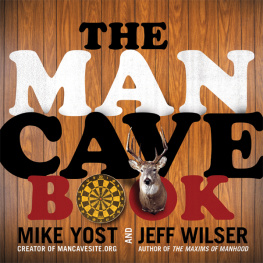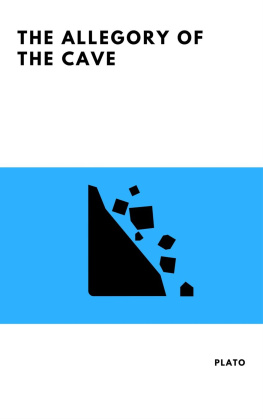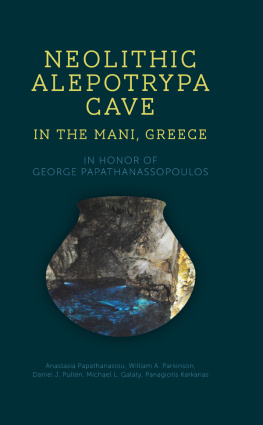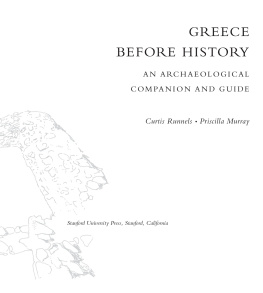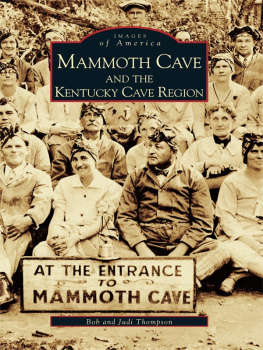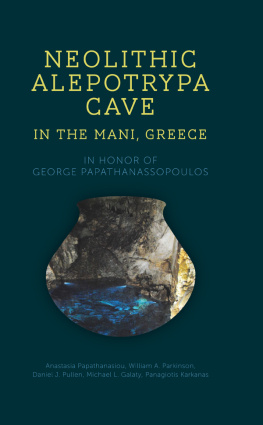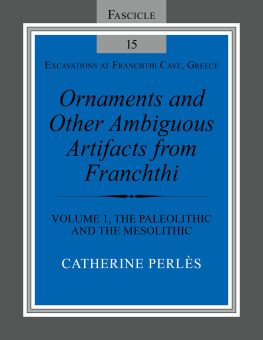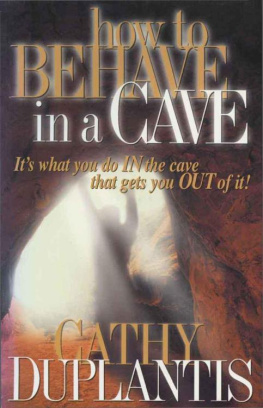Landscape and People of the Franchthi RegionExcavations at Franchthi Cave, Greece
T. W. Jacobsen, General Editor
FASCICLE 2
Landscape and People of the Franchthi Region
TJEERD H. VAN ANDEL and SUSAN B. SUTTON
with contributions by
Julie M. Hansen and
Charles J. Vitaliano
INDIANA UNIVERSITY PRESS
Bloomington & Indianapolis
1987 by Tjeerd H. van Andel and Susan B. Sutton
All rights reserved
No part of this book may be reproduced or utilized in any form or by any means, electronic or mechanical, including photocopying and recording, or by any information storage and retrieval system, without permission in writing from the publisher. The Association of American University Presses Resolution on Permissions constitutes the only exception to this prohibition.
Library of Congress Cataloging-in-Publication Data
Van Andel, Tjeerd H. (Tjeerd Hendrik), 1923-
Landscape and people of the Franchthi region.
(Excavations at Franchthi Cave, Greece ; fasc. 2) Bibliography: p.
1. LandformsGreeceFranchthi Cave Site Region. 2. Anthropo-geographyGreeceFranchthi Cave Site Region. 3. GreeceAntiquities. 4. Franchthi Cave Site (Greece) I. Sutton, Susan B. II. Title III. Series.
GB436.G8V36 1987 938.8 87-4156
ISBN 0-253-31975-7 (pbk.)
1 2 3 4 5 91 90 89 88 87
CONTENTS
(T. W. Jacobsen)
(Tjeerd H. van Andel)
(Tjeerd H. van Andel)
(C. J. Vitaliano)
(Tj. H. van Andel and C. J. Vitaliano)
(Tj. H. van Andel and J. M. Hansen)
(Susan B. Sutton)
FIGURES
TABLES
PLATES
FOREWORD
This volume is another component of the initial installment of four fascicles in the Franchthi final publication series. Unlike certain other components of the series (e.g., Perls 1987), it represents something of a compromise in that it offers primary data and levels of interpretation that transcend to a degree our conceptual distinction between levels of publication in this series (see, e.g., Jacobsen and Farrand 1987). Nevertheless, the nature of its contents is such that its appearance seemed most appropriate at this time and in this form.
The primary objectives of this volume are to provide necessary background for the other studies in the series and to introduce the reader to the study area in which the Franchthi excavations took place. As such, it helps to provide a context, both ancient and modern, for the excavations and resulting publications.
At the same time, this fascicle is valuable as a reminder to the reader of the fundamental relationship between our project and its parent enterprise, the Argolid Exploration Project. As described more fully elsewhere (Jacobsen, forthcoming), the AEP was conceived and organized by M. H. Jameson (then of the University of Pennsylvania), later evolved into a collaborative project with Indiana University (with the writer as co-director), and eventually came to be based at Stanford University (hence the occasional references in what follows to the Stanford Archaeological Survey). Both primary authors of this volume are members of that project, and van Andel serves as one of its co-directors. The full publication of the AEP-Stanford Survey is now in its final stages of preparation (Jameson, van Andel, and Runnels, forthcoming; see also van Andel and Runnels 1987), and it will incorporate, complement, and expand upon much of the information provided in this study.
This manuscript was completed by the authors, essentially in its present form, in June, 1986. The general editor would like to express his gratitude once again to Ms. Frances Huber and Ms. Mary Ann Weddle of the Program in Classical Archaeology at Indiana University and to our colleagues at the Indiana University Press, most notably Mr. John Gallman, Ms. Harriet Curry, and Ms. Roberta Diehl, for their considerable assistance and cooperation in the preparation of the manuscript for publication. The photographs in were taken by R. Grody, T. W. Jacobsen, S. B. Sutton, and M. and K. Sheehan. As always, we are most grateful to the Indiana University Foundation (E. A. Schrader Endowment for Classical Archaeology) and the National Endowment for the Humanities for their continuing support of our project.
T. W. JACOBSEN
PREFACE
I have long held the view that our ultimate goal is to determine the inter-relationships between culture and environment.
K. W. Butzer, Environment and Archaeology (1964)
Archaeological sites exist within a landscape, a landscape that may have changed substantially over time if it has been occupied long enough or if the inhabitants exerted enough pressure on their surroundings. This, among the many tasks of the archaeological geologist, is the most challenging, the study of a landscape in the context of its occupation and exploitation by human beings. Karl Butzer (1982:1-7) has suggested that the principal objective of any paleoenvironmental study ought to be the array of options presented to its exploiters at various times by a changing landscape. To this I would add the natural complement, the identification of changes in a landscape wrought accidentally or deliberately by its human inhabitants.
The principal options offered by any landscape are food, water, and raw materials, and also, though less often considered, shelter, healthfulness or its opposite, ease of travel, and accessibility from land or sea. The options vary with time and so do the selections human beings make among them. While hunter-gatherers seek what nature offers over large territories, agriculturists prefer landscapes that are easily molded to their needs.
It is obvious that this kind of study requires a broad range of environmental disciplines, including palynology, geology, paleoclimatology, and paleoceanography, as well as the information available from the archaeological sites themselves. In the following pages use will be made of many studies stimulated by the Franchthi excavations directed by T. W. Jacobsen, including what has already been put in print by archaeologists, paleozoologists, and paleoethnobotanists. Key elements also are the areally broader studies of the archaeological survey of the southern Argolid, the Argolid Exploration Project (Jameson et al., forthcoming).
Paleoenvironmental reconstructions, even those done with great skill and based on abundant data, suffer from the difficulty with which confidence limits are established. It would be far simpler to extrapolate backward from the present, assuming that the landscape has varied little and only in a minor way. Unfortunately, even leaving human influence aside, this assumption is not warranted for the past 50,000 years which include the large changes in climate, vegetation, and geography that accompanied the transition from a full glacial to the present late interglacial.
The following discussion of the Franchthi landscape emphasizes the period from ca. 100,000 B.P., long before clear evidence exists for the occupation of the cave, until the site record ends at about 5,000 B.P. The reports of the Argolid Exploration Project focus on the subsequent history with its intense human modification of the landscape (Jameson et al., forthcoming).
.
Another equally important perspective is provided by the study of traditional patterns of living in the area and by the events of its latest history. Greece has until very recently been a conservative society, and many still surviving approaches to economic and social issues have much to teach us regarding the possible cultural, social, and economic patterns in the more remote past. Until the 1940s and 1950s, threshing floors and wooden plows, as well as fallowing were common in agriculture, the construction of wooden boats of time-honored designs can still be observed today, and the construction of houses was, in many ways, not dissimilar to the medieval designs or even those of the later Bronze Age. Thus anthropological studies initiated by the Argolid Exploration Project and summarized in of this work offer much food for contemplation to those who must interpret the prehistoric past.


